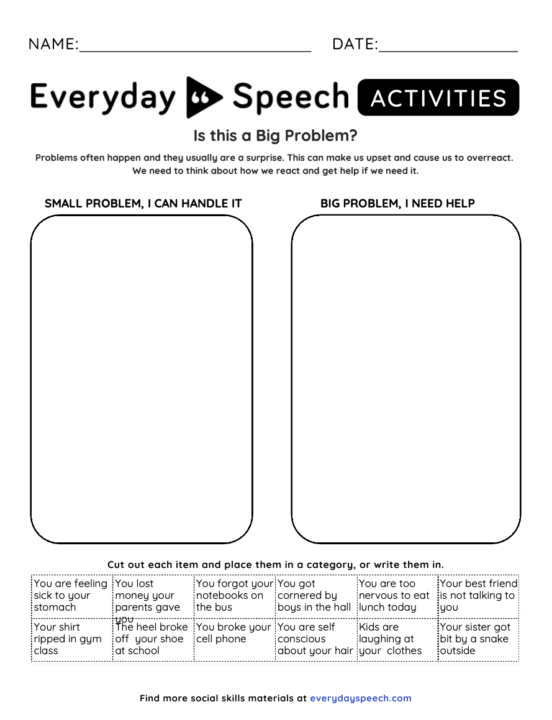Problem-solving is a crucial skill that empowers individuals to overcome challenges and find effective solutions. However, before students can tackle a problem, they need to understand the size of the problem at hand. By helping them assess whether a problem is big or small, we enable them to approach problem-solving with clarity and confidence.
In this article, we will explore strategies for teaching middle school students to determine the size of the problem. We provide a no-prep lesson plan and engaging activities that can be easily integrated into your 1-1 and small-group interventions:
Get Free Problem-Solving Activities for PK-12
No-prep worksheets, games, and lesson plans for your classroom or therapy sessions.
What is the ‘Size of the Problem’ Strategy?
Before delving into problem-solving strategies, it’s important for students to recognize that not all problems are created equal. By teaching them to assess the size of the problem, we help them develop a more nuanced perspective on challenges. This skill allows students to:
- Recognize the impact and urgency of different problems.
- Respond with an appropriate level of emotion and action.
- Identify whether they can solve the issue independently or need adult support.
By mastering this skill, students learn to manage their emotions, make thoughtful decisions, and improve their overall problem-solving abilities. This equips them with the ability to allocate appropriate resources, seek assistance when needed, and make informed decisions.
How to Teach ‘Size of the Problem’ to Middle Schoolers
Teaching middle school students to assess the size of a problem requires clear guidance and opportunities to practice. The goal is to help them recognize the impact of different challenges and develop an appropriate response. Here are key strategies to support this learning:
- Defining the Size of the Problem: Help students differentiate between minor and major challenges by asking key questions like, “Does this problem affect only me, or does it impact others?” and “What are the potential consequences?” Teach them that small problems can often be handled independently, while big problems may need additional support from an adult or peer.
- Assessing Emotional Impact: Guide students in identifying how problems influence their emotions. Encourage them to reflect on their feelings, recognize when emotions may be overwhelming, and determine whether a calming strategy or outside help is needed.
To effectively teach students about the size of the problem, we have created a comprehensive lesson plan that incorporates hands-on activities and interactive discussions. This no-prep lesson plan can be adapted to suit your counseling sessions and the unique needs of your students.
Get Free Problem-Solving Activities for PK-12
No-prep worksheets, games, and lesson plans for your classroom or therapy sessions.
Step-by-Step Lesson Plan: Teaching ‘Size of the Problem’
Teaching middle school students to determine the size of the problem is a fundamental step towards developing effective problem-solving skills. By enabling them to differentiate between small and big problems, we empower students to approach challenges with a more strategic mindset.
By utilizing the provided lesson plan and engaging activities, you can guide your students through the process of understanding the size of the problem.
Objective: To help middle school students identify whether a problem is big or small and understand the appropriate response for each.
Materials Needed:
- Whiteboard or flipchart
- Markers
- Sticky notes
- “Is this a Big Problem?” Activity from Everyday Speech (downloadable PDF)
1. Introduction: Problem-Solving & Categorization
Start with a discussion about problem-solving:
- How do you usually react to challenges?
- Are all problems equally difficult to solve?
- What makes some problems feel bigger than others?
Explain that determining the size of the problem helps us manage emotions and find the right solutions.
2. Discussion: Small vs. Big Problems Chart
Create a two-column chart labeled “Small Problems” and “Big Problems.”
- Brainstorm examples of different problems and list them under each category.
- Encourage students to provide real-life situations they have faced.
- Discuss how small problems can often be handled independently, while big problems may require support from an adult or teamwork.
3. Activity: ‘Is This a Big Problem?’ Worksheet
Reinforce the concept with the “Is this a Big Problem?” worksheet.
- Distribute the worksheet and ask students to categorize different scenarios as small or big problems.
- Encourage them to justify their choices to promote critical thinking.
- Facilitate a class discussion about different perspectives and interpretations.
- Encourage students to respect different perspectives and challenge their thinking.

4. Reflection and Closure
Conclude the lesson by encouraging students to reflect on what they have learned about determining the size of the problem. Discuss how this can enhance their problem-solving skills in various aspects of their lives.
Fostering problem-solving skills requires ongoing reinforcement and application. Encourage your students to practice assessing the size of problems in their daily lives, reinforcing their ability to adapt and tackle challenges.
With these essential problem-solving skills, our students will grow into resilient individuals who confidently navigate the complexities of life.
Want More? Access Additional Free Resources!
We offer a free 30-day trial where you can use our thousands of video lessons, worksheets, and games to teach social skills like problem-solving. Here’s an example video modeling lesson for teaching problem-solving skills from our curriculum:





